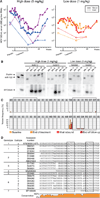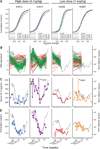Therapeutic silencing of microRNA-122 in primates with chronic hepatitis C virus infection
- PMID: 19965718
- PMCID: PMC3436126
- DOI: 10.1126/science.1178178
Therapeutic silencing of microRNA-122 in primates with chronic hepatitis C virus infection
Abstract
The liver-expressed microRNA-122 (miR-122) is essential for hepatitis C virus (HCV) RNA accumulation in cultured liver cells, but its potential as a target for antiviral intervention has not been assessed. We found that treatment of chronically infected chimpanzees with a locked nucleic acid (LNA)-modified oligonucleotide (SPC3649) complementary to miR-122 leads to long-lasting suppression of HCV viremia, with no evidence of viral resistance or side effects in the treated animals. Furthermore, transcriptome and histological analyses of liver biopsies demonstrated derepression of target mRNAs with miR-122 seed sites, down-regulation of interferon-regulated genes, and improvement of HCV-induced liver pathology. The prolonged virological response to SPC3649 treatment without HCV rebound holds promise of a new antiviral therapy with a high barrier to resistance.
Figures



Comment in
-
Antagonizing microRNA-122 and treatment of hepatitis C virus infection.Hepatology. 2010 Apr;51(4):1461-3. doi: 10.1002/hep.23573. Hepatology. 2010. PMID: 20373371 No abstract available.
Similar articles
-
In vitro antiviral activity and preclinical and clinical resistance profile of miravirsen, a novel anti-hepatitis C virus therapeutic targeting the human factor miR-122.Antimicrob Agents Chemother. 2015 Jan;59(1):599-608. doi: 10.1128/AAC.04220-14. Epub 2014 Nov 10. Antimicrob Agents Chemother. 2015. PMID: 25385103 Free PMC article. Clinical Trial.
-
Hepatitis C virus therapy: blocking the little microRNA helper of the virus.J Formos Med Assoc. 2010 Mar;109(3):173-6. doi: 10.1016/s0929-6646(10)60039-3. J Formos Med Assoc. 2010. PMID: 20440905 No abstract available.
-
HCV infection induces a unique hepatic innate immune response associated with robust production of type III interferons.Gastroenterology. 2012 Apr;142(4):978-88. doi: 10.1053/j.gastro.2011.12.055. Epub 2012 Jan 13. Gastroenterology. 2012. PMID: 22248663 Free PMC article.
-
[Overview of locked nucleic acid(LNA)- SPC3649 and its application in HCV treatment].Bing Du Xue Bao. 2011 Nov;27(6):614-8. Bing Du Xue Bao. 2011. PMID: 22263277 Review. Chinese. No abstract available.
-
Mechanisms involved in the development of chronic hepatitis C as potential targets of antiviral therapy.Curr Pharm Biotechnol. 2011 Nov;12(11):1774-80. doi: 10.2174/138920111798377030. Curr Pharm Biotechnol. 2011. PMID: 21902631 Review.
Cited by
-
Control of metastatic progression by microRNA regulatory networks.Nat Cell Biol. 2013 Jun;15(6):546-54. doi: 10.1038/ncb2769. Nat Cell Biol. 2013. PMID: 23728460 Free PMC article. Review.
-
Decreased miR122 in hepatocellular carcinoma leads to chemoresistance with increased arginine.Oncotarget. 2015 Apr 10;6(10):8339-52. doi: 10.18632/oncotarget.3234. Oncotarget. 2015. PMID: 25826076 Free PMC article.
-
microRNA-140 Inhibits Inflammation and Stimulates Chondrogenesis in a Model of Interleukin 1β-induced Osteoarthritis.Mol Ther Nucleic Acids. 2016 Oct 11;5(10):e373. doi: 10.1038/mtna.2016.64. Mol Ther Nucleic Acids. 2016. PMID: 27727249 Free PMC article.
-
MicroRNAs and liver disease.J Hum Genet. 2017 Jan;62(1):75-80. doi: 10.1038/jhg.2016.53. Epub 2016 May 26. J Hum Genet. 2017. PMID: 27225852 Review.
-
Modulating Anti-MicroRNA-21 Activity and Specificity Using Oligonucleotide Derivatives and Length Optimization.ISRN Pharm. 2012;2012:407154. doi: 10.5402/2012/407154. Epub 2012 Feb 7. ISRN Pharm. 2012. PMID: 22474606 Free PMC article.
References
Publication types
MeSH terms
Substances
Associated data
- Actions
Grants and funding
LinkOut - more resources
Full Text Sources
Other Literature Sources
Molecular Biology Databases

